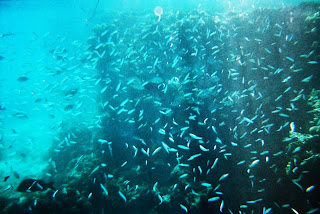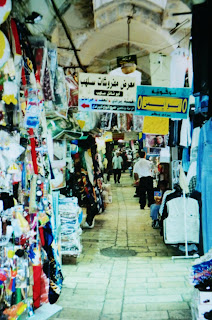A Review of the whole Trip to Israel 2000.
Our two-week trip to Israel in 2000 was more adventurous than expected because we arrived just before Rosh Hashanah, the Jewish New Year. Unlike in the West when New Year's Day always falls on the first day of January, in Israel, the date is movable, as with our Easter corresponding with their Passover.
Therefore, our first few days were difficult. We were stranded in Haifa without cash to pay for transport to our destination, Stella Carmel Christian Conference Centre in Isfya, a village about ten miles or 16 km from Haifa. Yet, at the summit of the Carmel Ridge, a kind taxi driver who was also a church minister offered us a free lift to the Centre. We then returned to the city a couple of days later with the erroneous idea that the holiday was over and all shops reopened.
In a city of closed shops, it was also next to a miracle that we found just one shop open for trading during the holiday, a pharmacy that with caution, cashed a traveller's cheque, enabling us to pay another taxi driver to take us safely back to the Centre.
We then took an Egged Bus south to Jerusalem where we booked into the New Swedish Backpacker's hostel where we were allocated a hotel-type private bedroom with a double bed.
The Jewish Sukkot, or the Festival of Booths, was ongoing by the time we arrived at the Jewish capital. Although this was a special week in the Jewish calendar, all shops and public institutions were open for trading and administration. The number of coloured booths temporarily installed on the streets of New City not only created a spectacular sight but also brought Biblical life to a first-hand experience.
It was while we were staying in Jerusalem that we went out on two separate day trips. The first one included a four-hour bus journey to Eilat. There was a resort that seemed so far away from any unrest taking place around Jerusalem, and it was here on the west coast of the Gulf of Aqaba, the natural home of a fringe coral reef which made the four-hour journey worthwhile.
On another morning, we took another bus to En Gedi, in the desert bordering the west coast of the Dead Sea. It was in this dramatic mountainous oasis at the Rift Valley where we followed the Nahal David, a freshwater stream flowing down several waterfalls from a spring, and flowing towards the Dead Sea. One of the waterfalls fed a shallow pool where public bathing was allowed. We took advantage and managed to swim in the natural setting.
Our Last Day was spent in Tel Aviv.
As my Travel Biography has always testified, every good thing must come to an end, and the morning of take-off back home in the UK was only 24 hours away. So on our final morning in Jerusalem Old City, we vacated our hostel room and with a rucksack on my back, we completed our final walk through Jaffa Street to arrive at the Egged Bus station to board a bus for Tel Aviv.
This was to be the very last time we walked the streets of Jerusalem for the rest of my life, as I hadn't returned since 2000, and there was little chance of ever returning in our present lifetimes. One reason is my age and declining health. Another reason was the construction of the West Bank Barrier along the Green Line. It was first proposed as far back as 1992 by then-Prime Minister Yitzhak Rabin.
Began in 1994 with a short 2 km stretch between Bat Hefer and Tulkarm, the latter just over 61 km or 38 miles north of Jerusalem as the crow flies, construction along the Green Line bordering the West Bank with Israel is still ongoing as I write. It's an ugly concrete monstrosity blemishing the Beautiful Land, but Israel felt the need for extra security following a spate of Palestinian terrorist attacks. However, if I wanted to walk through the streets of the Old City and stand on the Mount of Olives, I wouldn't see much of the barrier or any of it at all, as its nearest point from the city wall is around two kilometres away. However, at present (2024), if I wanted to take a bus out of Jerusalem to Bethlehem, Hebron, En Gedi, Masada, or Eilat, we would need to pass through the checkpoint at least once, probably twice for the southernmost regions in the future.
All that is a deterrent from ever visiting the Holy Land again. It's such a tragedy for humanity - especially for Christian and Jewish believers!
However, there shouldn't be any checkpoints for Journeys from Jerusalem to Tel Aviv, Haifa, and other coastal points north. Such was the case in 2000, when Alex and I boarded the express bus to Tel Aviv. After leaving Jerusalem, the hilly terrain on which the city is built recedes into the distance and the land flattens out as we headed towards the Mediterranean. This flat strip of land is the Plain of Sharon.
 |
| Facing south towards Jaffa (Joppa) |
 |
| Modern hotels line the seafront. |
We arrive at the Tel Aviv bus station after about an hour's journey. This city, once the capital of Israel before the status was handed over to Jerusalem in July 1980, saw Tel Aviv as a modern Western city bustling with life. Although a Jewish settlement, it was almost entirely secular with little religious influence, unlike Jerusalem Old City, instead with its coast lined with hotels, not unlike the shoreline of Eilat. Rather, I would rate Tel Aviv as brash, very much like Brighton in the UK.
South of Tel Aviv is Jaffa or the Biblical Joppa. It's the site where Peter lodged at a tanner's home before the servants of Cornelius arrived to escort a reluctant Peter to the home of the first Gentile, a non-Jewish Roman Centurian, to be converted to the Christian faith. Unfortunately, we didn't get around to visiting Joppa, even if we were able to see it from where we were on the beach. A monastery dominates the city, as it's built on a hill. It's part of St Peter's Church, and I wouldn't be surprised if it's on the site of the former tannery.
But with the heavy rucksack on my back, and also realising that we had no bed for the coming night, I wanted just to wind down, to spend the last full day in Israel relaxing on the sandy beach.
A beach holiday? Why not? It's only for one day and there will be no nightclubs or alcohol consumption. Funny that. Back in 1976, I also spent the last day in Israel on the beach at Tel Aviv and I had the same thoughts. The dreadful experience in 1972 with excess alcohol consumption in Spain apparently had lasting effects, perhaps even stretching over 28 years (or 52 years now).
The respite included having a swim in the sea under warm sunshine in a cloudless sky. However, if I wanted to make a comparison between the Mediterranean Sea and the Gulf of Aqaba, the latter would win hands down. Not only do the corals thrive in the Gulf where snorkelling with an underwater camera would result in spectacular photos, but the sea is backed by the mountains of Jordan, with the colour of a pink hue during the late afternoon and early evening, therefore, giving a true otherworldly perspective of foreign travel. By contrast, the Mediterranean is seen, especially by the British but probably by the Germans as well, as a sunseeker's paradise, an ideal location to spend a two-week escape from the harsh realities of life, especially under cool grey skies and chilly winds characteristic of a temperate climate.
I even read in one travel magazine (an issue of Wanderlust) some years ago that there are more interesting places to visit rather than the boring Mediterranean - and then proceeded to give a list of faraway places around the world. At this point, I disagree. The lands surrounding the Med offer plenty of historical sites, ancient - even predating the Roman period - and more recent such as Medieval. Adding to all that, there are many spectacular geological sites of natural beauty. I could conclude that the Med is either a paradise for the hiker, photographer or historian, or a sunseeker's haven where sun, sand, sea, and alcohol dominate. Or worst of all, before my Christian conversion in 1972, spending what was left of the night sleeping in a Spanish bathtub, wet with my own vomit.
But I also understand where Wanderlust was coming from. For someone who fell in love with corals making up a reef teeming with marine life, the average Briton would need to travel further away than the Med. Indeed, aquariums housing coral in an artificial environment would make it ideal for a family's day out, but the aquarium would never equal the sheer joy of actually diving or snorkelling along the reef and experiencing marine life firsthand.
Preparing for the Flight Home.
 |
| Beach life with our luggage. |
 |
| Sunset at Tel Aviv, |
Alex and I spent most of the day at the beach in Tel Aviv right until sundown. Afterwards, it was time to head for the airport and spend the night in the check-in lounge. However, I was concerned about security. They will ask us where we stayed whilst we were in Israel, and I have to answer that we stayed in a Palestinian-owned hostel. That alone would step up security.
The bus to Ben Gurion Airport was slow, passing through the residential estates. But we eventually arrived. We were checked at the main entrance security (like at Tel Aviv Bus Station) and we were free to wander around the check-in terminal, as our flight to London was one of the first take-offs of the day. We both sat down and tried unsuccessfully to sleep as we tried to pass that long night.
About halfway through the night, a female security officer approached and offered us to pass through security. We were led to the security room and we had our luggage thoroughly examined. When they were satisfied that we posed no threat, our luggage had a zillion stickers plastered over them, eliminating any further security searches.
Hence, when the check-in desk opened, we passed through easily with no ado. We then proceeded to the upstairs departure lounge.
However, the plane we were in remained at the terminal for a long time. The announcement came through the tannoy. A passenger has changed his mind about flying to London and refusing to board, the luggage hold had to be opened and his property retrieved before the plane could take off.
As I looked out of the window at the scene below, I recognised Rhodes straight away. The walls of Rhodos Old City stood out in the sunshine amidst the rich blue Mediterranean. Afterwards, as we landed at London Gatwick to be met by the chill of Autumn, I knew that one chapter of my life was about to close and another open.
-----------------------------------------------------------------------------------------------------------------
Next Week: The one event which ends this Biography.















































